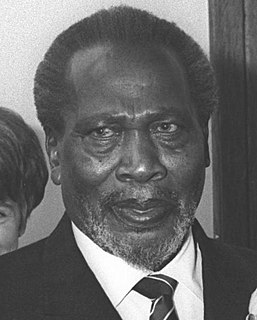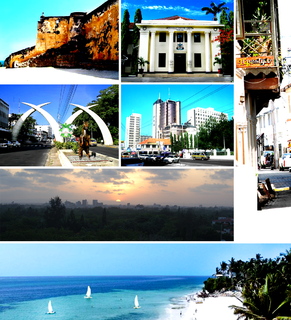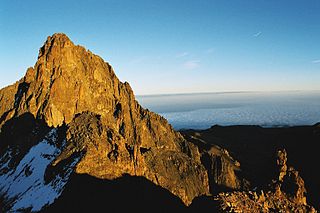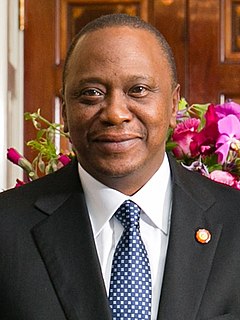This article needs additional citations for verification .(October 2021) |
Nanyeni is a village in Western Province, Kakamega county, Kenya, located in the west of Matungu district. [1]
This article needs additional citations for verification .(October 2021) |
Nanyeni is a village in Western Province, Kakamega county, Kenya, located in the west of Matungu district. [1]

A part of Eastern Africa, the territory of what is now Kenya has seen human habitation since the beginning of the Lower Paleolithic. The Bantu expansion from a West African centre of dispersal reached the area by the 1st millennium AD. With the borders of the modern state at the crossroads of the Bantu, Nilo-Saharan and Afro-Asiatic ethno-linguistic areas of Africa, Kenya is a truly multi-ethnic state.

The Economy of Kenya is a market-based economy with a few state enterprises. Major industries include agriculture, forestry, fishing, mining, manufacturing, energy, tourism and financial services. As of 2020, Kenya had the third largest economy in Sub-Saharan Africa, coming behind Nigeria and South Africa.

Nairobi is the capital and the largest city of Kenya. The name comes from the Maasai phrase Enkare Nairobi, which translates to "cool water", a reference to the Nairobi River which flows through the city. The city proper had a population of 4,397,073 in the 2019 census, while the metropolitan area has a population of 9,354,580. The city is popularly referred to as the Green City in the Sun.
Kenya Airways Ltd., more commonly known as Kenya Airways, is the flag carrier airline of Kenya. The company was founded in 1977, after the dissolution of East African Airways. Its head office is located in Embakasi, Nairobi, with its hub at Jomo Kenyatta International Airport.

The Kenya African National Union (KANU) is a Kenyan political party that ruled for nearly 40 years after Kenya's independence from British colonial rule in 1963 until its electoral loss in 2002. It was known as Kenya African Union (KAU) from 1944 to 1952. The KAU was banned by the colonial government from 1952 to 1960. It was re-established by James Gichuru in 1960 and renamed KANU on 14 May 1960 after a merger with Tom Mboya's Kenya Independence Movement.

The Mau Mau Uprising (1952–1960), also known as the Mau Mau Rebellion, the Kenya Emergency, and the Mau Mau Revolt, was a war in the British Kenya Colony (1920–1963) between the Kenya Land and Freedom Army (KLFA), also known as Mau Mau, and the British authorities.

Jomo Kenyatta was a Kenyan anti-colonial activist and politician who governed Kenya as its Prime Minister from 1963 to 1964 and then as its first President from 1964 to his death in 1978. He was the country's first indigenous head of government and played a significant role in the transformation of Kenya from a colony of the British Empire into an independent republic. Ideologically an African nationalist and conservative, he led the Kenya African National Union (KANU) party from 1961 until his death.

Kenya, officially the Republic of Kenya, is a country in Eastern Africa. At 580,367 square kilometres (224,081 sq mi), Kenya is the world's 48th largest country by total area. With a population of more than 47.6 million people in the 2019 census, Kenya is the 29th most populous country. Kenya's capital and largest city is Nairobi, while its oldest city and first capital is the coastal city of Mombasa. Kisumu City is the third-largest city and also an inland port on Lake Victoria. Other important urban centres include Nakuru and Eldoret. As of 2020, Kenya is the third-largest economy in sub-Saharan Africa after Nigeria and South Africa. Kenya is bordered by South Sudan to the northwest, Ethiopia to the north, Somalia to the east, Uganda to the west, Tanzania to the south, and the Indian Ocean to the southeast.

Mombasa is a coastal city in southeastern Kenya along the Indian Ocean. The city is known as the white and blue city in Kenya. It is the country's oldest and second-largest city, with a population of about 1,208,333 people according to the 2019 census. Its metropolitan region is the second-largest in the country, and has a population of 3,528,940 people.

Mount Kenya is the highest mountain in Kenya and the second-highest in Africa, after Kilimanjaro. The highest peaks of the mountain are Batian, Nelion and Point Lenana. Mount Kenya is located in the former Eastern and Central provinces of Kenya, now Meru, Embu, Laikipia, Kirinyaga, Nyeri and Tharaka Nithi counties, about 90 kilometres north of the equator, around 150 km (90 mi) north-northeast of the capital Nairobi. Mount Kenya is the source of the name of the Republic of Kenya.

Uhuru Muigai Kenyatta is a Kenyan politician who has served as the fourth and President of Kenya since 2013. He served as the member of parliament (MP) for Gatundu South from 2002 to 2013. He also served as Deputy Prime Minister from 2007 to 2013. Currently, he is a member and the party leader of the Jubilee Party of Kenya. Uhuru was previously associated with the Kenya Africa National Union (KANU) before founding The National Alliance (TNA), one of the allied parties that campaigned for his election during the 2013 general elections and later on went to form a merger with the William Samoei Ruto's United Republican Party (URP) to form the Jubilee Party. Uhuru's tenure has been marred by endless cases of corruption and impunity.

The Kenya national cricket team represents the Republic of Kenya in international cricket. Kenya is an associate member of the International Cricket Council (ICC) which has Twenty20 International (T20I) status after the ICC granted T20I status to all of their members.
The Kenya national football team represents Kenya in international football. It is controlled by the Football Kenya Federation, the governing body football in Kenya, and competes as a member of the Confederation of African Football (CAF) and the Council for East and Central Africa Football Associations (CECAFA), a sub-confederation of CAF that has jurisdiction in East and Central Africa. The team is colloquially known as the Harambee Stars and plays its home games primarily at the Nyayo National Stadium in the country's capital, Nairobi. The team is yet to qualify for the FIFA World Cup competition.

The culture of Kenya consists of multiple traditions and trends. Kenya has no single prominent culture that identifies it. Its cultural heritage and modern expressions of culture instead consist of various cultures, shaped and practiced by the country's different communities.

Kenya Summer Moore Daly is an American actress, model, producer, author, television personality, and entrepreneur. She co-starred in the Bravo series The Real Housewives of Atlanta from 2012 onwards and was a member of the cast of The Celebrity Apprentice 7 in 2015. Moore rose to prominence in 1993 after winning the Miss USA contest which led her to compete in that year's Miss Universe pageant ultimately landing her among the top six. She subsequently appeared in films and television shows including Waiting To Exhale (1995) and Deliver Us From Eva (2003), The Steve Harvey Show (1998) and Girlfriends (2004). Moore has produced several film projects, had a book published, and starred in her own exercise video. She is also known for her involvement in entrepreneurial ventures and is the founder of hair care brand, Moore Hair.

The Sultanate of Zanzibar, also known as the Zanzibar Sultanate, was a state controlled by the Sultan of Zanzibar, in place between 1856 and 1964. The Sultanate's territories varied over time, and at their greatest extent spanned all of present-day Kenya and the Zanzibar Archipelago of the Swahili Coast. After a decline, the state had sovereignty over only the archipelago and a 16-kilometre-wide (10 mi) strip along the Kenyan coast, with the interior of Kenya constituting the British Kenya Colony and the coastal strip administered as part of that colony de facto.

The Colony and Protectorate of Kenya, commonly known as British Kenya, was part of the British Empire in Africa. It was established when the former East Africa Protectorate was transformed into a British Crown colony in 1920. Technically, the 'Colony of Kenya' referred to the interior lands, while a 16 km (10 mi) coastal strip was the 'Protectorate of Kenya', but the two were controlled as a single administrative unit. The colony came to an end in 1963 when a black majority government was elected for the first time and eventually declared independence as Kenya.

The counties of Kenya are geographical units envisioned by the 2010 Constitution of Kenya as the units of devolved government. The powers are provided in Articles 191 and 192, and in the fourth schedule of the Constitution of Kenya and the County Governments Act of 2012. The counties are also single-member constituencies for the election of members of parliament to the Senate of Kenya and special women members of parliament to the National Assembly of Kenya. As of 2013 general elections, there are 47 counties whose size and boundaries are based on the 47 legally recognised districts of Kenya. Following the re-organisation of Kenya's national administration, counties were integrated into a new national administration with the national government posting county commissioners to represent it at the counties.

On Saturday, 21 September 2013, four masked gunmen attacked the Westgate shopping mall, an upscale mall in Nairobi, Kenya. There are conflicting reports about the number killed in the attack, since part of the mall collapsed due to a fire that started during the siege. The attack resulted in 71 total deaths, including 62 civilians, five Kenyan soldiers, and four attackers. Approximately 200 people were wounded in the mass shooting.
The COVID-19 pandemic in Kenya is part of the worldwide pandemic of coronavirus disease 2019 caused by severe acute respiratory syndrome coronavirus 2. The virus was confirmed to have reached Kenya on 12 March 2020, with the initial cases reported in the capital city Nairobi and in the coastal area Mombasa.